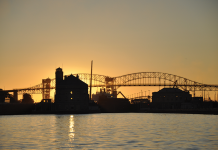By Chuck Warren | Photography by Chuck Warren
Four years ago, most boat owners were easily able to step aboard their vessels by barely lifting their feet. Today, with Lake Michigan water levels more than 5 feet above the record lows of 2015, and Lake Huron equally brimming past capacity, many are finding it difficult to climb aboard. Boats along the state’s coastline are riding high.
Ken Wall has been selling fuel, food and supplies to Lake St. Clair boaters at Michigan Harbor for 54 years. He and others watched the high waters flood cottages and waterfront businesses in 1986 when lake levels set record after record.
“This is different,” Wall said. “A lot of people will argue with me, but I know it’s higher than ’86.”
Wall’s employees now slosh across the flooded steel dock in knee-high rubber boots while boaters stopping for fuel all perform elaborate gymnastics to disembark. With most boats floating 3 or more feet higher than normal, the usual exit paths from the boat to the dock are nearly impossible to traverse.

As water levels around the Great Lakes break longstanding records, the effects are obvious in many areas. Sandbags line the top of a seawall in Saugatuck where several waterfront properties struggle to keep the water out of motel rooms and retail space. Some get by with pumps running to control the flood, but others have lost the battle.
Lakeshore businesses have seen other effects. Electrical lines supplying waterfront structures are often hidden below the floor, where they can become submerged when the water levels rise. Damaged insulation, conduits and bare wires can create a life-threatening condition if someone falls in the water. Falling off the dock becomes a real possibility when waters are so high that people can’t see the edge.
Wall hangs a throw ring on a rope outside his office door for just such emergencies.
“If they go in where there’s electricity in the water, you can’t go in after them or you’ll be shocked too,” Wall said. “This is the best we can do.”

In Douglas, where a steady stream of people launch their boats at the public ramp, the Kalamazoo River is wide and deep enough for small boats to run upriver to fish or to cruise and sightsee. But going anywhere now takes constant vigilance. This year’s high waters have loosened woody debris like stumps and branches or other trash that have been lodged on shorelines. When swept into the current, it gets transported elsewhere, where it settles once waters recede, at times becoming hidden obstructions for boaters.
A partially submerged stump or branch can mean the end of the boating season for anyone unlucky enough to strike it. A tree limb or scrap of lumber that is sucked into the boat’s propellers while turning at 2,000 or more rpm can destroy props and bend shafts, bringing a boat owner’s season to a quick end.
“Navigation has become a real challenge,” said Deputy Floyd Webber of the Allegan County Sheriff’s Office. “With many of the docks and seawalls submerged, people don’t have visual references. They’re running over stuff they would normally see.”

The same issues exist in many of the waterfront parks and in coastal parking lots where dividers and curbs are out of sight.
“People are running over hidden obstructions on land and in the water,” Webber said.
However, the high water doesn’t change his responsibilities.
“At the end of the day, we still do our jobs the same way,” he said. ≈
Chuck Warren is a freelance boating writer and licensed captain who lives in Grandville.








Facebook Comments